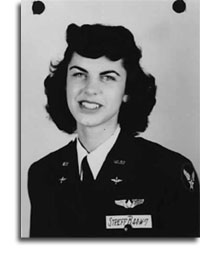| Annie G. Fox |
![]()
Although women were not allowed to participate in battle, they did serve
in so-called "noncombat" missions. These missions often proved to be extremely
dangerous.
The Women's Auxiliary Ferrying Squadron
(WAFS/WASP)
In September 1942, the Army Air Force (AAF)
created the Women's Auxiliary Ferrying Squadron (WAFS) and appointed Nancy
H. Love its commander. Love recruited highly skilled and experienced female
pilots who were sent on noncombat missions ferrying planes between factories
and AAF installations. While WAFS was being organized, the Army Air Force
appointed Jacqueline Cochran as Director of Women's Flying Training. Cochran's
school, which eventually moved to Avenger Field in Sweetwater, TX, trained
232 women before it ceased operations. Eventually, over 1000 women completed
flight training. As the ranks of women pilots serving the AAF swelled,
the value of their contribution began to be recognized, and the Air Force
took steps to militarize them. As a first step the Air Force renamed their
unit from WAFS to Women Airforce Service Pilots (WASP).
 |
 |
 |
Pilots like Betty Bachman, Ann Criswell, and Betty Jo Streff were considered Civil Service employees of the AAF WAFS/WASP.
 |
|
Barbara Erickson became the first WASP to receive the Air Medal for Meritorious Achievement as a Pilot. Erickson received her medal for completing four 2,000 mile deliveries of three different types of aircraft in slightly more than 5 days of actual flying. Although not allowed to fly combat missions, WAFS/WASP pilots served grueling, often dangerous, tours of duty. Ferrying and towing were risky activities, and some WAFS/WASP pilots suffered injuries and were killed in the course of duty. In 1977, after much lobbying of Congress, the WASP finally achieved military active duty status for their service.
|